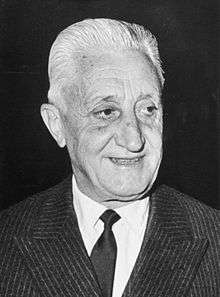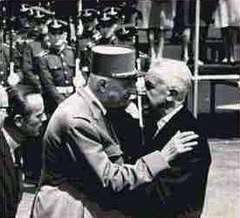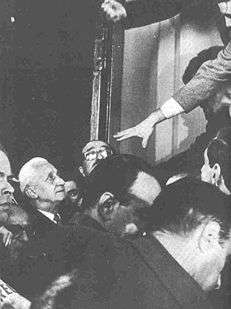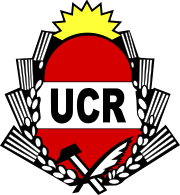Arturo Umberto Illia
Arturo Umberto Illia (Spanish pronunciation: [aɾˈtuɾo umˈbeɾto ˈilja]; August 4, 1900 – January 18, 1983[1]) was an Argentine politician and physician, who was President of Argentina from October 12, 1963 to June 28, 1966.[2] He was a member of the centrist Radical Civic Union.
His Excellency Arturo Illia | |
|---|---|
 | |
| President of Argentina | |
| In office October 12, 1963 – June 28, 1966 | |
| Vice President | Carlos Humberto Perette |
| Preceded by | José María Guido |
| Succeeded by | Juan Carlos Onganía |
| Member of the Chamber of Deputies for Córdoba | |
| In office April 20, 1948 – April 30, 1952 | |
| Vice Governor of Córdoba | |
| In office June 17, 1940 – June 19, 1943 | |
| Governor | Santiago H. del Castillo |
| Preceded by | Alejandro Gallardo |
| Succeeded by | Asís Ramón |
| Member of the Córdoba Senate for Cruz del Eje | |
| In office May 1, 1936 – April 24, 1940 | |
| Preceded by | Fidel Torres |
| Succeeded by | Nicolás Pedernera |
| Personal details | |
| Born | Arturo Umberto Illia August 4, 1900 Pergamino, Buenos Aires, Argentina |
| Died | January 18, 1983 (aged 82) Córdoba, Argentina |
| Resting place | La Recoleta Cemetery, Buenos Aires |
| Nationality | Argentine |
| Political party | Radical Civic Union |
| Spouse(s) | |
| Alma mater | University of Buenos Aires |
| Signature |  |
Biography
Arturo Umberto Illia was born in Pergamino, Buenos Aires, to Emma Francesconi and Martín Illia, Italian immigrants from the Lombardy Region.
He enrolled in the School of Medicine at the University of Buenos Aires in 1918. That year, he joined the movement for University reform in Argentina (Reforma Universitaria), which first emerged in the city of Córdoba, and set the basis for a free, open and public university system less influenced by the Catholic Church. This development changing the concept and administration of higher education in Argentina, and in a good portion of Latin America.[3]
As a part of his medical studies, Illia begun working in the San Juan de Dios Hospital in the city of La Plata, obtaining his degree in 1927.
In 1928 he had an interview with President Hipólito Yrigoyen, the longtime leader of the centrist UCR, and the first freely-elected President of Argentina. Illia offered him his services as a physician, and Yrigoyen, in turn, offered him a post as railroad physician in different parts of the country, upon which Illia decided to move to scenic Cruz del Eje, in Cordoba Province. He worked there as a physician from 1929 until 1963, except for three years (1940–1943) in which he was Vice-Governor of the province.
Family
On February 15, 1939, he married Silvia Elvira Martorell,[4][5] and had three children: Emma Silvia, Martín Arturo and Leandro Hipólito. Martín Illia was elected to Congress in 1995, and served until his death in 1999.
Gabriela Michetti, elected Vice President in 2015, is a great-grandniece of Illia.
Political activities
Arturo Illia became a member of the Radical Civic Union when he reached adulthood, in 1918, under the strong influence of the radical militancy of his father and of his brother, Italo. That same year, he began his university studies, with the events of the aforementioned Universitarian Reform taking place in the country.
From 1929 onwards, after moving to Cruz del Eje, he began intense political activity, which he alternated with his professional life. In 1935 he was elected Provincial Senator for the Department of Cruz del Eje, in the elections that took place on November 17. In the Provincial Senate, he actively participated in the approval of the Law of Agrarian Reform, which was passed in the Córdoba Legislature but rejected in the National Congress.
He was also head of the Budget and Treasury Commission, and pressed for the construction of dams, namely Nuevo San Roque, La Viña, Cruz del Eje and Los Alazanes.
In the elections that took place on March 10, 1940, he was elected Vice-Governor of Córdoba Province, with Santiago del Castillo, who became governor. He occupied this post until the provincial government was replaced by the newly installed dictatorship of General Pedro Ramírez, in 1943.
From 1948 to 1952, Illia served in the Argentine Chamber of Deputies. Working in a Congress dominated by the Peronist Party, he took an active part in the Public Works, Hygiene and Medical Assistance Commissions.
Election as President of Argentina
.jpg)
After the fall of the government of Juan Perón in 1955, a long period of political instability took over Argentina.
From 1955 to 1963 the country had five presidents. Frondizi governed the country from May 1, 1958 until March 29, 1962, when he was overthrow by a military coup. Frondizi's removal was precipitated by his lifting the ban on Peronism ahead of the March 1962 mid-term elections. After Frondizi the President of the Senate José María Guido became interim President of the country, starting a process of 'normalization' which eventually led to new elections on July 7, 1963.
The 1963 elections were made possible by support from the moderate, "Blue" faction ((in Spanish) Azules) of the Argentine military, led by the Head of the Joint Chiefs, General Juan Carlos Onganía and by the Internal Affairs Minister, General Osiris Villegas. The UCR had been divided since their contentious 1956 convention into the mainstream "People's UCR" (UCRP) and the center-left UCRI. The leader of the UCRP, Ricardo Balbín, withdrew his name from the March 10 nominating convention and instead supported a less conservative, less anti-Peronist choice, and the party nominated Dr. Illia for President and Entre Ríos Province lawyer Carlos Perette as his running-mate.[6]
In the electoral college on July 31, 1963, the Illia-Perette ticket obtained 169 votes out of 476 on the first round of voting (70 short of an absolute majority), but the support of three centrist parties on the second round gave them 270 votes, thus formalizing their election.[7]
Presidency

Arturo Illia became president on October 12, 1963, and promptly steered a moderate political course, while remaining mindful of the spectre of a coup d'état. A UCRP majority in the Senate contrasted with their 73 seats in the 192-seat Lower House, a disadvantage complicated by Illia's refusal to include UCRI men in the cabinet (which, save for Internal Affairs Minister Juan Palmero, would all be figures close to Balbín). Illia also refused military requests to have a general put in charge of the Federal District Police, though he confirmed Onganía as Head of the Joint Chiefs of Staff and named numerous "Blue" generals to key posts.[6]
Countering military objections, he made political rights an early policy centerpiece, however. His first act consisted in eliminating all restrictions over Peronism and its allied political parties, causing anger and surprise among the military (particularly the right-wing "Red" faction). Political demonstrations from the peronist party were forbidden after the 1955 coup, by the Presidential Decree 4161/56, however, five days after Illia's inaugural, a Peronist commemorative act for the October 17 (in honor of the date in 1945 when labor demonstrations propelled Perón to power) took place in Buenos Aires' Plaza Miserere without any official restrictions. Illia similarly lifted electoral restrictions, allowing the participation of Peronists in the 1965 legislative elections. The prohibition over the Communist Party of Argentina and the pro-industry MID (which many in the military, then controlled by cattle barons, termed "economic criminals") was also lifted. Among Illia's early landmark legislation was an April 1964 bill issuing felony penalties for discrimination and racial violence, which he presented in an address to a joint session of Congress.[6]
Domestically, Illia pursued a pragmatic course, restoring Frondizi's vigorous public works and lending policies, but with more emphasis on the social aspect and with a marked, nationalist shift away from Frondizi's support for foreign investment. This shift was most dramatic in Illia's energy policy.[8]
Petroleum policy
On November 15, 1963, Illia issued the decrees 744/63 and 745/63, which rendered said oil contracts null and void, for being considered "illegitimate and harmful to the rights and interests of the Nation.".
Frondizi had begun, during his 1958–62 presidency, a policy of oil exploration based on concessions of oil wells to foreign private corporations, leaving the state oil company Yacimientos Petrolíferos Fiscales (YPF) the sole responsibility of exploration and buying oil from private extractors. Arguing that such contracts were negative for the Argentine state and its people (YPF had to assume all the risks of investing in exploration of new wells, the price of oil had risen steadily since the contracts were negotiated, etc.), Illia denounced the Frondizi policy as negative for national Argentine interests, and promised to render the contracts of concession void, renegotiating them.
Minimum, Vital and Mobile Wage Law
On June 15, 1964, the Law 16.459 was passed, establishing a minimum wage for the country. "Avoiding the exploitation of workers in those sectors in which an excess of workforce may exist", "Securing an adequate minimum wage" and "Improving the income of the poorest workers" were listed among the objectives of the project.
With the same aims, the Law of Supplies was passed, destined to control prices of basic foodstuffs and setting minimum standards for pensions.
Education policy
During Illia's government, education acquired an important presence in the national budget. In 1963, it represented 12% of the budget, rising to 17% in 1964 and to 23% in 1965.
On November 5, 1964, the National Literacy Plan was started, with the purpose of diminishing and eliminating illiteracy (At the time, nearly 10% of the adult population was still illiterate). By June 1965, the program comprised 12,500 educational centers and was assisting more than 350,000 adults of all ages.
Medical drugs law
Law 16.462, also known as 'Oñativia Law' (in honor of Minister of Health Arturo Oñativia), was passed on August 28, 1964. It established a policy of price and quality controls for pharmaceuticals, freezing prices for patented medicines at the end of 1963, establishing limits to advertising expenditures and to money sent outside the country for royalties and related payments. The regulation of this law by Decree 3042/65 also required pharmaceutical corporations to present to a judge an analysis of the costs of their drugs and to formalize all their existing contracts.
Supporters, detractors and impartial observers of Illia all agree that this policy helped to create opposition by business interests that was decisive in his eventual overthrow by a military coup.
Economic policy
In the economic sphere, Arturo Illia's presidency was characterised by regulation of the public sector, a decrease of the public debt, and a considerable push for industrialization. The Syndicate of State Businesses was created, to achieve a more efficient control of the public sector. Among his brief presidency's most notable public works initiatives were the Villa Lugano housing development (in the poorest section of Buenos Aires) and El Chocón Dam, then the largest such project in Argentina.
National GDP had contracted by 2.4% in 1963; it expanded by 10.3% in 1964 and 9.1% in 1965. Industrial GDP had shrunk by 4.1% in 1963; it leapt by 18.9% in 1964 and 13.8% in 1965. The external debt was reduced from 3.4 billion dollars to 2.7 billion.[8]
The median real wage grew by 9.6% during calendar 1964, alone, and had expanded by almost 25%, by the time of the coup.[9] Unemployment declined from 8.8% in 1963, to 5.2% on 1966.
Ironically, the Argentine middle class (who were generally as anxious as anyone to see President Illia leave office) benefited even more: auto sales leapt from 108,000 in 1963 to 192,000 in 1965 (a record at the time).[10]
Cabinet
| Office | Holder | Term |
| President | Arturo Illia | 1963–1966 |
| Vice President | Carlos Perette | 1963–1966 |
| Ministry of Foreign Affairs | Miguel Ángel Zavala Ortíz | 1963–1966 |
| Ministry of Economics | Alfredo Blanco | 1963–1965 |
| Juan Carlos Pugliese | 1965–1966 | |
| Ministry of Defense | Leopoldo Suárez | 1963-1963 |
| Ministry of the Interior | Juan S. Palmero | 1963–1966 |
| Ministry of Education and Culture | Carlos Alconada Aramburu | 1963–1966 |
| Ministry of Social Assistance and Public Health | Arturo Oñativia | 1963–1966 |
| Ministry of Public Services | Miguel Angel Ferrando | 1963–1966 |
| Ministry of Work and Social Security | Fernando Solá | 1963–1966 |
Coup and early end of presidency

Organized labour initially supported Illia for his expansionist economic policy. This support turned to antagonism during 1964, however, as secret plans for Perón's return from exile took shape. Accordingly, CGT labor union head José Alonso called a general strike in May, and became a vocal opponent of the president's – this antagonism intensified after Perón's failed attempt to return in December, and during 1965, CGT leaders began publicly hinting at support for a coup.[6]
Legislative elections took place on March 17, and despite the unions' hostility towards Illia, Peronists were free of the restrictions existing up to 1963. Thanks to this, the Peronists presented their own party lists, rallying behind the Popular Union. The Popular Union won the popular vote (3,278,434 votes against Illia's UCRP, which obtained 2,734,970 votes), and elected 52 Congressmen (the first time Peronists had been allowed to do so in a decade).[8]
The triumph of the Peronists shook the Argentine Armed Forces, both among internal military factions linked to the Peronist movement, and in particular among the large section of the army which remained strongly anti-Peronist. In addition, a campaign against the government was also being carried out by important parts of the media, notably Primera Plana and Confirmado, the nation's leading newsmagazines. Seizing on minimally relevant events such as the President's refusal to support Operation Power Pack (Lyndon Johnson's April 1965 invasion of the Dominican Republic), Illia was nicknamed "the turtle" in both editorials and caricatures, and his rule was vaguely referred to as "slow," "dim-witted" and "lacking energy and decision," encouraging the military to take power and weakening the government even more; Confirmado went further, publicly exhorting the public to support a coup and publishing a (non-scientific) opinion poll touting public support for the illegal measure.[6]
Under the planning of the Commander of the First Division of the Army, General Julio Alsogaray, and with the support of the military, economic groups, a considerable part of the media, and numerous politicians (notably UCRI leader Oscar Alende, former President Frondizi, and Alsogaray's brother, right-wing economist Alvaro Alsogaray), the military coup took place on June 28, 1966. General Alsogaray presented himself in Illia's office that day, at 5:00 a.m, and 'invited' him to resign his post.[11]

Illia refused to do so at first, citing his role as Commander-in-Chief, but at 7:20, after seeing his office invaded by military officers and policemen with grenade launchers, he was forced to step down. The next day, General Juan Carlos Onganía became the new Argentine President.
Illia lost his wife, Silvia Martorell, to cancer in November of that year. He then relocated to the upscale Buenos Aires suburb of Martínez, though he would still make frequent trips to Córdoba. He continued participating in politics actively in support of the UCR until his death in Córdoba on January 18, 1983.
Following a state memorial in Congress, Arturo Umberto Illia was buried in La Recoleta Cemetery, in Buenos Aires.
References
- (in Spanish) buscabiografias.com
- "ARTURO UMBERTO ILLIA (1963 – 1966)". Argentine Government. Retrieved September 29, 2019.
- Crawley, Eduardo. A House Divided: Argentina, 1880–1980. London: St. Martin's Press, 1985. ISBN 0905838742
- Pandolfi, Rodolfo & Gibaja, Emilio (2008). La democracia derrotada. Arturo Illia y su época. Buenos Aires: Lumiere. p. 57. ISBN 9789876030526.
- "MDZ Online". Archived from the original on December 8, 2015. Retrieved November 29, 2015.
- Potash, Robert. The Army and Politics in Argentina. Stanford University Press, 1996. ISBN 0804706832
- Nohlen, Dieter. Elections in the Americas. Oxford University Press, 2005.
- Rock, David.Argentina: 1516–1982. University of California Press, 1987. ISBN 0520051890
- UN Development Programme: Study on the Distribution of Income in Argentina. New York: UN Statistical Division, 1971.
- Mercado interno – Domestic Market Archived October 31, 2008, at the Wayback Machine. Historical Sales Data. ADEFA.com.ar
- Presidencia de Illia. Todo Argentina. (in Spanish)
Further reading
| Wikimedia Commons has media related to Arturo Umberto Illia. |
- Arturo Illia, su vida, principios y doctrina, by Ricardo Illia, Ediciones Corregidor.
- La caída de Illia, by Mario Antonio Verone, Editorial Coincidencia.
- Historia del radicalismo, by Mario Monteverde, GAM Ediciones.
- La presidencia de Illia, by Pedro Sánchez, CEAL.
- Poder militar y sociedad política en Argentina (Tomo II, 1943–1973), by Alan Rouquié, Emecé Editores.
- ¿Qué es el radicalismo?, by Raúl Alfonsín, Editorial Sudamericana.
| Political offices | ||
|---|---|---|
| Preceded by José María Guido |
President of Argentina 1963–1966 |
Succeeded by Juan Carlos Onganía |
| Government offices | ||
| Preceded by Alejandro Gallardo |
Vice Governor of Córdoba 1940–1943 |
Succeeded by Ramón Asìs |
